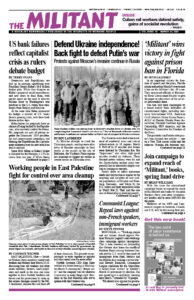LINCOLN, Neb. — Railroad derailments are increasing in many states, with Nebraska among those with the highest number of train derailments. Since 2000, a train has derailed in the state roughly once every seven days.
The Feb. 3 derailment in East Palestine was a “wake-up call,” Andrew Foust, state legislative director of Nebraska Sheet Metal, Air, Rail and Transportation Workers Transportation Division (SMART-TD), said at the March 6 Nebraska Senate Transportation and Telecommunications Committee hearing on the rail industry.
The hearing was attended by nearly 70 rail union members.
The increasing numbers of derailments are no surprise to rail workers, who have seen rail bosses eliminate thousands of jobs in recent years in their drive to boost profits at the expense of safety for workers and those who live along the tracks.
Many of the proposals being considered by the state Senate committee involved new regulations for the industry. But reliance on the capitalist rulers and their government bureaucracy not only doesn’t work, it cuts across preparing workers to use union power, the most important thing they’ve got, and to tap the deep well of solidarity from other unionists and the working-class public if we fight. This is the only road to win larger crews, shorter trains and safe working conditions.
“These hearings are a stage that working people can use to present a clearer picture of the dangers of the working conditions in the railroad industry that unions will have to change,” I said in the two minutes I had to speak before the committee.
“My union brothers and sisters are not naive, we know the railroad employers and their stockholders will do whatever is in their best interests, meaning profit.
“The long-term effects on workers and working farmers in the area since the Ohio derailment that led to the contamination of the air, soil, and water is still to be seen,” I said, “but I’m sure you can understand the anger and fear people in East Palestine and people living in the rural areas have.
“Union workers need to organize to take control over their working conditions. Trains should be no longer than 50 cars, with a minimum crew of four, two on head and two on the rear.”

